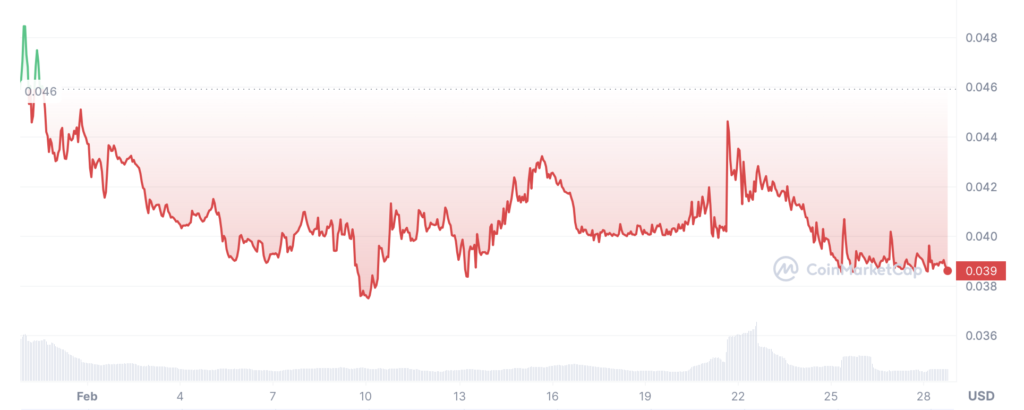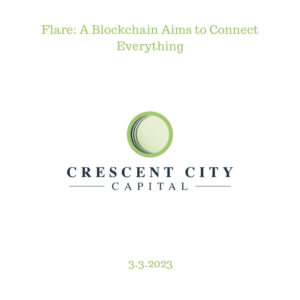Flare: A Blockchain Aims to Connect Everything
By Tyshe Jiang | Crescent City Capital Market Analyst Intern

What is FLARE
Flare is a layer one Ethereum Virtual Machine and runs the proof of stale consensus that brings smart contract and interoperability capabilities to blockchains. The network has two open native interoperability protocols: the State Connector and the Flare Time Series Oracle (FTSO). Flare was founded mainly by three people: Hugo Philion, Sean Rowan, and Dr. Nairi Usher in 2022.
At first, the team planned to create a chain that would allow the tokens from layer 1 networks to be used with the smart contracts. Then the team shifted their focus to research more and engineer the platform. They aim to connect all layer one blockchains as what we saw right now using three methods: cross-chain interoperability, secure data acquisition, and information delay.
By using Ethereum Virtual Machine (EVM), users can do the execution and deployment of smart contracts on the Ethereum blockchain. It also provides a platform for developers to create decentralized apps (DApps). The EVM performs a similar function on the Flare Network by executing smart contracts and hosting DApps. As a result, Ethereum developers can easily switch to the Flare network.
Interoperability Protocols
The Flare Time Series Oracle (FTSO) is a decentralized oracle for time series data, such as asset prices, data indices, and more. An Oracle brings real-world information or information from other blockchains. Unlike Chainlink, Flare provides decentralized oracles to the blockchain world. FTSO supports the platform to run smart contracts on the network that provides continuous estimations for data securely. The system is intended to encourage the reporting of correct pricing. At launch, the system will provide pricing in USD for XRP, ETH, BTC, and other cryptocurrencies.

The State Connector enables the state of an external blockchain to be captured in a decentralized manner on-chain. Through this, Flare can track the state of the connections in another blockchain for safer bridges. This is achieved by using two core protocols: the request-commit-reveal (RCR) and the branching protocol. The RCR protocol’s objective is to collect user queries and proofs about blockchains, whereas the branching protocol’s purpose is for the network to accept or reject these.
FLR Token
The Flare token (FLR) is the native token of the Flare crypto ecosystem, which has been called Spark. The FLR token, like many other native tokens, is used to engage with smart contracts and pay transaction fees. Users may also wrap FLR into WFLR, allowing the asset to be utilized for oracle delegation and as collateral in a variety of decentralized finance (DeFi) protocols. It may hold in a margin or arbitrage trading account to cover any possible losses made by a trader when trading with leverage. Also, the holders can participate within protocol governance. Last but not least, FLR also incentivized delegation to the FTSO to support the provision of reliable decentralized price data.
Recent Updates
The Flare price on Feb 28th is $0.038730 USD with a 24-hour trading volume of $10,908,026 USD. It has a circulating supply of 11,999,991,148 FLR coins. In December 2022, there was a snapshot saying that the XRP holders are eligible to exchange one XRP for one XRP. Right now, the airdrop begins but gradually to avoid dumping.

Summary
Flare is a pretty new platform, So its future is hard to predict. However, according to the current data and research, its ability to make blockchains interoperable, and Flare Crypto uses a new consensus mechanism called Proof of Stake Time (PoST) which allows it to process many more transactions than other cryptocurrencies and attracts new investors. Flare Crypto also has built-in decentralized user exchanges which all trade directly with each other without having to go through a centralized exchange. But one of its competitors is Chainlink, which has already toke a lot of market share and exposure. And the airdrop still needs to last for 36 months, and the variables of inflation and token are not easy to control.
References:
https://flare.network/wp-content/uploads/Flare-White-Paper-v2.pdf
https://beincrypto.com/learn/flare-network/#h-how-does-the-flare-network-work

